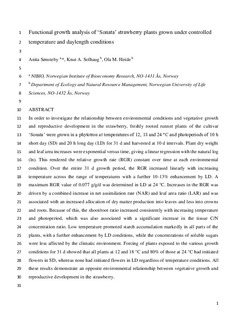| dc.contributor.author | Sønsteby, Anita | |
| dc.contributor.author | Solhaug, Knut Asbjørn | |
| dc.contributor.author | Heide, Ola M. | |
| dc.date.accessioned | 2017-12-07T09:44:55Z | |
| dc.date.available | 2017-12-07T09:44:55Z | |
| dc.date.created | 2016-10-03T14:06:23Z | |
| dc.date.issued | 2016 | |
| dc.identifier.citation | Scientia Horticulturae. 2016, 211 26-33. | nb_NO |
| dc.identifier.issn | 0304-4238 | |
| dc.identifier.uri | http://hdl.handle.net/11250/2469518 | |
| dc.description.abstract | In order to investigate the relationship between environmental conditions and vegetative growth and reproductive development in the strawberry, freshly rooted runner plants of the cultivar ‘Sonata’ were grown in a phytotron at temperatures of 12, 18 and 24 °C and photoperiods of 10 h short day (SD) and 20 h long day (LD) for 31 d and harvested at 10 d intervals. Plant dry weight and leaf area increases were exponential versus time, giving a linear regression with the natural log (ln). This rendered the relative growth rate (RGR) constant over time at each environmental condition. Over the entire 31 d growth period, the RGR increased linearly with increasing temperature across the range of temperatures with a further 10–13% enhancement by LD. A maximum RGR value of 0.077 g/g/d was determined in LD at 24 °C. Increases in the RGR was driven by a combined increase in net assimilation rate (NAR) and leaf area ratio (LAR) and was associated with an increased allocation of dry matter production into leaves and less into crowns and roots. Because of this, the shoot/root ratio increased consistently with increasing temperature and photoperiod, which was also associated with a significant increase in the tissue C/N concentration ratio. Low temperature promoted starch accumulation markedly in all parts of the plants, with a further enhancement by LD conditions, while the concentrations of soluble sugars were less affected by the climatic environment. Forcing of plants exposed to the various growth conditions for 31 d showed that all plants at 12 and 18 °C and 80% of those at 24 °C had initiated flowers in SD, whereas none had initiated flowers in LD regardless of temperature conditions. All these results demonstrate an opposite environmental relationship between vegetative growth and reproductive development in the strawberry. | nb_NO |
| dc.language.iso | eng | nb_NO |
| dc.rights | Attribution-NonCommercial-NoDerivatives 4.0 Internasjonal | * |
| dc.rights.uri | http://creativecommons.org/licenses/by-nc-nd/4.0/deed.no | * |
| dc.title | Functional growth analysis of ‘Sonata’ strawberry plants grown under controlled temperature and daylength conditions | nb_NO |
| dc.type | Journal article | nb_NO |
| dc.type | Peer reviewed | nb_NO |
| dc.description.version | acceptedVersion | nb_NO |
| dc.source.pagenumber | 26-33 | nb_NO |
| dc.source.volume | 211 | nb_NO |
| dc.source.journal | Scientia Horticulturae | nb_NO |
| dc.identifier.doi | 10.1016/j.scienta.2016.08.003 | |
| dc.identifier.cristin | 1389031 | |
| dc.relation.project | Norges forskningsråd: 225254 | nb_NO |
| cristin.unitcode | 192,14,0,0 | |
| cristin.unitname | Miljøvitenskap og naturforvaltning | |
| cristin.ispublished | true | |
| cristin.fulltext | postprint | |
| cristin.qualitycode | 1 | |

